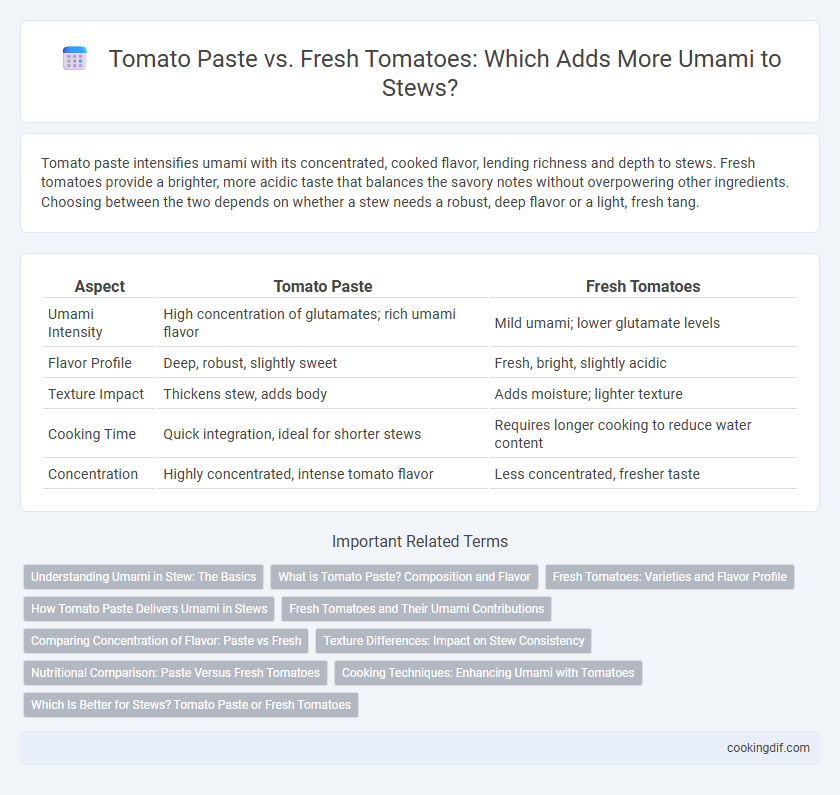Tomato paste intensifies umami with its concentrated, cooked flavor, lending richness and depth to stews. Fresh tomatoes provide a brighter, more acidic taste that balances the savory notes without overpowering other ingredients. Choosing between the two depends on whether a stew needs a robust, deep flavor or a light, fresh tang.
Table of Comparison
| Aspect | Tomato Paste | Fresh Tomatoes |
|---|---|---|
| Umami Intensity | High concentration of glutamates; rich umami flavor | Mild umami; lower glutamate levels |
| Flavor Profile | Deep, robust, slightly sweet | Fresh, bright, slightly acidic |
| Texture Impact | Thickens stew, adds body | Adds moisture; lighter texture |
| Cooking Time | Quick integration, ideal for shorter stews | Requires longer cooking to reduce water content |
| Concentration | Highly concentrated, intense tomato flavor | Less concentrated, fresher taste |
Understanding Umami in Stew: The Basics
Tomato paste contains a concentrated amount of glutamates and nucleotides, key compounds responsible for umami richness in stew, delivering a deeper, more intense savory flavor compared to fresh tomatoes. Fresh tomatoes contribute a brighter, fresher acidity and provide natural sugars that balance overall taste while still adding subtle umami notes through their inherent amino acids. Combining both ingredients can optimize umami layering, enhancing the stew's complexity and mouthfeel by leveraging the concentrated umami of tomato paste and the vibrant freshness of fresh tomatoes.
What is Tomato Paste? Composition and Flavor
Tomato paste is a concentrated product made by cooking down ripe tomatoes until most of the water evaporates, resulting in a thick, rich paste with intense umami flavor. Its composition includes natural sugars, acids, and glutamates, which enhance the savory depth of stews more effectively than fresh tomatoes. The concentrated umami compounds in tomato paste provide a robust, slightly sweet, and tangy taste that intensifies the overall flavor profile of the dish.
Fresh Tomatoes: Varieties and Flavor Profile
Fresh tomatoes offer a diverse flavor profile that enhances umami without overpowering a stew's balance. Varieties such as Roma, heirloom, and vine-ripened bring different levels of sweetness, acidity, and depth, which intensify umami through natural glutamates. Using fresh tomatoes allows for a layered, vibrant taste that evolves during slow cooking, enriching the overall stew complexity.
How Tomato Paste Delivers Umami in Stews
Tomato paste delivers concentrated umami in stews through its high glutamate content, which intensifies savory depth and richness. Slow cooking tomato paste caramelizes its natural sugars, enhancing Maillard reactions that boost flavor complexity. This concentrated form reduces watery texture, creating a thicker stew with a robust umami profile compared to fresh tomatoes.
Fresh Tomatoes and Their Umami Contributions
Fresh tomatoes enhance stew with natural glutamates and nucleotides, vital compounds that amplify umami flavor. Their vibrant, tangy profile provides a more nuanced and layered taste compared to tomato paste. Incorporating fresh tomatoes enriches the stew's depth by balancing acidity and sweetness, resulting in a complex umami experience.
Comparing Concentration of Flavor: Paste vs Fresh
Tomato paste offers a concentrated umami flavor due to its reduced moisture content, intensifying the natural glutamates responsible for savoriness, whereas fresh tomatoes provide a lighter, more balanced flavor with higher water content diluting the taste. The cooking process of tomato paste enhances its depth, making it ideal for stews requiring a rich, robust base. Fresh tomatoes contribute brightness and acidity, complementing but not overpowering the savory notes found more potently in tomato paste.
Texture Differences: Impact on Stew Consistency
Tomato paste intensifies umami while thickening stew due to its concentrated, smooth texture, creating a rich and velvety consistency. Fresh tomatoes release more water, resulting in a lighter, chunkier stew with a fresher, less dense texture. Choosing between the two affects the final stew's mouthfeel and body, balancing depth of flavor with desired thickness.
Nutritional Comparison: Paste Versus Fresh Tomatoes
Tomato paste offers a concentrated source of umami due to its reduced water content and higher levels of glutamates, resulting in a richer, more intense flavor compared to fresh tomatoes. Nutritionally, tomato paste contains higher amounts of lycopene, a powerful antioxidant linked to heart health and reduced cancer risk, while fresh tomatoes provide more vitamin C and hydration due to their higher water content. Using tomato paste in stews enhances depth and nutritional density, whereas fresh tomatoes contribute freshness and essential vitamins, making both valuable depending on the desired flavor profile and nutrient focus.
Cooking Techniques: Enhancing Umami with Tomatoes
Tomato paste intensifies umami through concentrated flavors developed by slow cooking and caramelization, creating a rich, savory base in stews. Fresh tomatoes contribute a lighter umami, releasing natural glutamates when simmered gently to preserve brightness and balance acidity. Combining both forms at different cooking stages optimizes the depth and complexity of umami in savory stew preparations.
Which Is Better for Stews? Tomato Paste or Fresh Tomatoes
Tomato paste delivers concentrated umami and rich flavor, making it ideal for deep, savory stews that require prolonged cooking. Fresh tomatoes offer a lighter, more acidic taste with a natural sweetness that brightens stew aromas but may not provide the same depth of umami as concentrated paste. Choosing tomato paste enhances the stew's savory complexity, while fresh tomatoes contribute freshness and slight tang, balancing richness depending on the desired stew profile.
Tomato Paste vs Fresh Tomatoes for Umami Infographic

 cookingdif.com
cookingdif.com